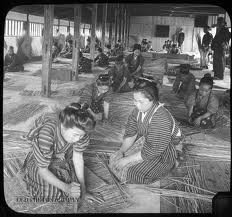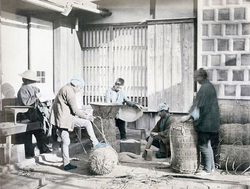Meiji Restoration: The Opening of Japan
The Cost of Modernization

Women working in a crowded factory
- The switch from a agricultural to an industrial economy led to misery to Japanese factory workers.
- Early Japanese factories were dark and dangerous and the work hours were very long, 12-14 hours a day.
- Diseases such as tuberculosis spread within crowded cities.
- many workers were women and children who received low wages and were treated like slaves.
- The replacement of technology made traditional methods obsolete which upset the older generations of Japanese.

Japanese Men Harvesting Rice (1880)
